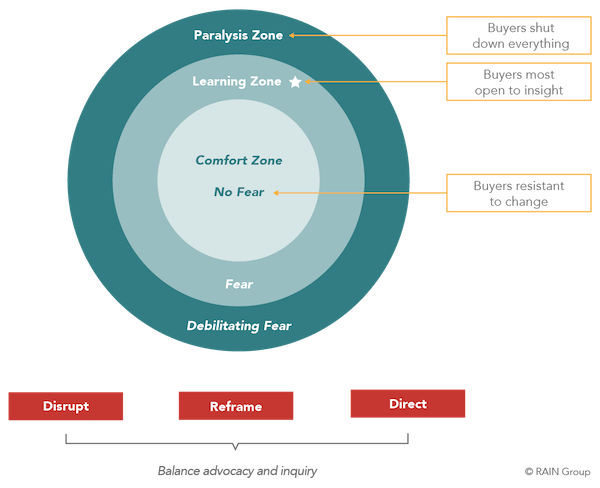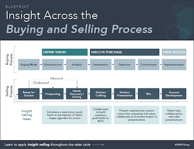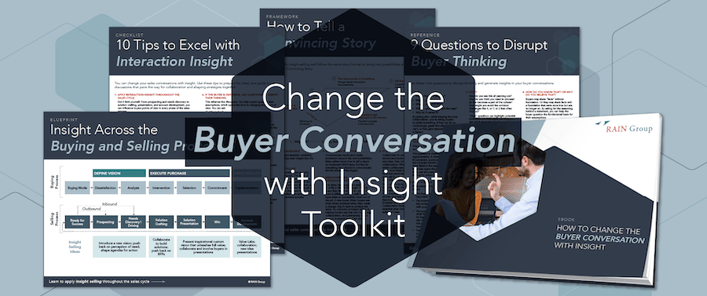The following is an excerpt from our new toolkit for sellers, How to Change the Buyer Conversation with Insight. Click here to access it. >>
Think about buyers you've worked with who were trying to move an initiative or agenda forward. You probably heard something like:
"We only need support in these areas from you."
"The team has decided to engage an outside provider to deliver on X."
"We're open to ideas about Y, but don't want to talk about Z."
These buyers are in their comfort zone: either comfortable with what they're trying to accomplish or how they're trying to accomplish it.
In some cases, there may be a good reason for it. It's possible they've already invested a great deal of time and resources into what they believe the solution should be.
But many buyers are headed down paths that won’t serve them well. This is because they don’t know what you know or that something better might be possible.
Your job is to help buyers make the best decisions, which often means making different decisions.
Making different decisions is uncomfortable. Thus, by definition, it doesn’t happen in the comfort zone. You need to help buyers move to a place where there’s some discomfort. In education theory—and insight selling—we call this the learning zone. It’s where insight happens.

If the buyer is in their comfort zone, your first step is to guide them out. You must get them to question their beliefs and assumptions to put their mindset in the right mode for learning.
But don’t guide them out too forcefully. If they feel you’re applying too much pressure, they may shut down completely. When people get overwhelmed, they’ll move past the learning zone into the paralysis zone.
Your goal is to get buyers to question their agenda for action, or perception of how to approach something, enough to open their minds. To do this, you need to disrupt, reframe, and direct.

Disrupt, Reframe, and Direct the Discussion with Buyers
People are guided by their belief systems—what they believe to be true:
- “W doesn’t work.”
- “There are only two ways to approach X.”
- “We can’t solve issue Y. We tried.”
- “We don’t need to do Z.”
Once beliefs are formed and in place, people don’t have to think about them much. There’s no mental processing required. You accept your beliefs and are typically comfortable in your knowledge and belief. But:
- What if W does work?
- What if there’s a third approach to X?
- What if you can solve Y by trying something different?
- What if you don’t do Z and over the next two years your competitors take a big lead on you?
By asking questions, you can disrupt buyers’ thinking and what they believe is true. Questions can lead the buyer to open their mind to change and can move them out of their comfort zone and into the learning zone. This is where you reframe and direct.
- “W does work, and here’s how.”
- “There’s a third, and even a new fourth, approach to X, and here’s what they are.”
- “In my experience, Y’s root cause is typically misidentified. One of my clients approached it this other way and saw massive returns.”
It’s questions (inquiry) that disrupt thinking in the first place. Once you do that, you can reframe the discussion and direct buyers down a better path (advocacy). Inquiry and advocacy are a powerful combination.
|
Get 9 questions (+1 bonus) to disrupt buyer thinking in our new How to Change the Buyer Conversation with Insight Toolkit. |
The Powerful Combination of Advocacy and Inquiry
Asking questions will help you uncover a buyer’s initial perception of need, but it can also uncover hidden needs when you ask “why” and “how” questions.
And advocacy will help drive new ideas and new thinking.
Here’s an example of how a seller can move a buyer out of the comfort zone using inquiry (questions) and advocacy (statements and stories).
Seller: “What do you think you need to do to increase sales growth, not just by 3% per year, but by as much as 9%?” [Inquiry]
Buyer: “Well, I’m not sure that’s possible.”
Seller: “I think it might be. By the time we’re done discussing, hopefully it’ll become clearer to both of us if it is. [Advocacy – This is where you disrupt.] One of my other customers, Jim Smith over at ACME, was in the same situation. It turned out three strategies he hadn’t been considering previously helped drive growth from about 3% to 12%.” [Advocacy – Reframe the issue.]
Challenging the buyer is the most direct way to nudge them out of their comfort zone. This is about being assertive, not pushy. It’s about opening minds to new thinking, which happens when people question their assumptions.
To do this, you need to:
- Be willing to ask questions geared towards driving buyers out of their comfort zone, so you can guide them to achieve the best value and outcome possible.
- Be prepared with very good questions, stories, and defensible advice.
If what the buyer is thinking, what they’re planning to do, or how they’re planning to do it won’t get them to their best outcome, your goal is to disrupt that thinking, reframe the discussion, and direct them to something that will.
|
Learn to apply insight in your sales conversations in our new How to Change the Buyer Conversation with Insight Toolkit. |
3 Ways to Respond to Buyer Pushback
When you disrupt buyer thinking, you'll often get some degree of defensiveness from buyers. After all, they may have spent weeks or months getting to where they are today with their plans and thinking.
Here are some common buyer reactions and how to respond:
-
1. The buyer might say, “Yeah, well, I don’t think so.”
This is where you can ask questions to disrupt their thinking, such as:
- “Why is that?”
- “What have you done before?”
- “Why don’t you think it’ll work?”
- “Why would the other way work better in terms of getting you the outcome you want?”
By asking disruption questions, you help buyers question their assumptions. You might not have changed their point of view—yet!—but you opened the door to it, and you’ll begin to demonstrate your value.
-
2. If the buyer is quite defensive, stonewalling even, they may say, “That’s not what we need.”
You could treat this as defensiveness and ask disruption questions, but be careful. You don’t want the buyer to think you’re being obstinate or not listening. Tune into the nuance of the conversation and try to hear what they’re actually saying.
-
3. If the buyer says, “We can’t do that,” or, “I don’t think so,” or is otherwise defensive, it could simply be a conditioned response.
Be prepared for buyers to reject new ideas initially. Many people are conditioned to immediately say no when presented with something new.
Or maybe they just don’t want to change because they’re in their comfort zone. Or they may think your idea isn't plausible or helpful, or they think you aren't listening. Or they simply don’t want to do more thinking or work.
This is where your deep knowledge of product and services, company, solutions, client, industry, competition, and so forth come in. Being comfortable and knowledgeable in these areas equips you to apply insight selling. If you know the buyer has overlooked something that’ll have a significant impact on their success, you can open the door to insight with the questions you ask.
Reframe Buyer Thinking with Insight
When you disrupt buyer thinking, take care to think about the maximum value a buyer can achieve in their situation. Think about getting them the best possible outcome. Then they may also see that they can, and should, get better results by thinking differently.
Many buyers—and people in general—think too small at first. If you can think big, and get buyers thinking about strong results, they’ll see you as valuable and become emotionally attached to driving the best solution forward.
There's more to insight selling than leading excellent conversations. Our free toolkit, How to Change the Buyer Conversation with Insight, provides frameworks and tools to help you ask incisive questions and get buyers thinking differently. The toolkit includes:
- Ebook: How to Change the Buyer Conversation with Insight
- Reference: 9 Questions (+1 Bonus) to Disrupt Thinking for Interaction Insight
- Framework: How to Tell a Convincing Story
- Checklist: 10 Tips to Excel with Interaction Insight
- Blueprint: Insight Across the Buying and Selling Process








